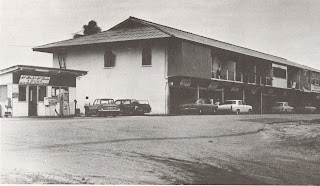Old Muara Revisited
 Does anyone remember the old Jin Tong's filling station at the end of the shophouses in Muara? It's no longer there as the Port has expanded right up to the edge of the shophouses. My better half told me that the late Jin Tong used to have another shop in front of Customs in Bandar. Anyway, I received an e-mail from a Muara resident or to be exact a Serasa resident when I posted the picture of old Muara and a couple of other old Brunei photographs. I liked the informal writing style. I have already received permission from the sender to reproduce the email and here it is (with some slight editing and removal of some sensitive material as requested):-
Does anyone remember the old Jin Tong's filling station at the end of the shophouses in Muara? It's no longer there as the Port has expanded right up to the edge of the shophouses. My better half told me that the late Jin Tong used to have another shop in front of Customs in Bandar. Anyway, I received an e-mail from a Muara resident or to be exact a Serasa resident when I posted the picture of old Muara and a couple of other old Brunei photographs. I liked the informal writing style. I have already received permission from the sender to reproduce the email and here it is (with some slight editing and removal of some sensitive material as requested):-Firstly sorry for the intrusion, but I'd just like to thank you for posting the early pic of Muara town. I have never seen any photo older than that of Muara town. My family and I live in Seasa, so Muara is very close by and somewhere which I often go to. Anyway, my dad hail from Serasa. So I showed him the pic of the old Muara town, just to test his memory. Didn't tell him any details at all. After looking at it for a good minute he recognised it as as the old Muara town. The thing which gave it away was the rail track. My dad is 57 years old. The picture was taken before he was born. So you're right about the year when the picture was shot, 30s/40s.
My dad also remembers the shops on the pic. He says the shop house belongs to Hj M*. During my dad's time, the shop house didn't look as good as it did in the pic as a row of shop houses had already been opened and affected some of the business. I think. Although the original row of shophouses has long disappeared, it has been replaced on the exact same spot as the one which are currently still standing housing cafes, bakery and other shops. Sorry, I have this habit of digressing.
Anyway, back to the original story. So the shophouse which belonged to Hj M* used to even sell bullets for hunting firearms and stuff. By looking at the picture, I thought the house was at least partially made of concrete and thinking some remains could still be there. Apparently not. The structures were made of kayu bulian, hence when the shophouse finally gave away, no remains left of the house. The spot of this house is exactly where the bungalow shops are right now in the second pic. The wooden building next to the rubber depository was a row of shophouses as well.
Since my dad was in the mood of telling old stories, he also mentioned that, the rail tracks also came to Serasa right up to the Serasa ugama school junction. The reason for the rail track was not for coals though. They were there to carry tmber all harvested from Serasa. These timber were used in the coal mines, I guess to build arches and stuff. There was a station or a spot where all the coals were collected before it was exported. This spot was located around the area where the flats are close to where the Electrical Department building is now.
Also, I'm not certain when this was, but at around the the time when they were still mining the coal - according to my dad, there was a great white big house built on the hill just behind the Electrical Department old building (now the complaint section). This house has also long gone. But I bet the remains are still there as it was made completely or partially of concrete. This house belonged to the company mining the coal, which I think once belonged to Rajah Brook himself. My dad remembers there used to be many beautiful and interesting bottles lying around the area. I think they were alchohol bottles. heheh
Also just another info. Sorry if you already know all these and I'm boring you. I promise this is the last one. When the British Resident was still in Brunei, my grandfather used to work as a gardener for the house which became a temporary Istana before Istana Nurul Izzah was opened. The British Resident use this house as a retreat. Anyway, my story isn't about any of that but about batu kelikir (gravel). Did you know that the road leading to this house also had batu kelikir? My dad and grandfather used to collect them to sell as side income. The road was lined with Chinese and Iban houses who collected or mine the batu kelikir for a living. I guess there weren't that much of them and that they were not mined commercially.
Before I end this, please note all the facts and figures are not based on anything concrete. I have not done any research on them. Just passing you some stories from my dad's own childhood memories. So I hope you've enjoyed them and may find them helpful.

Comments